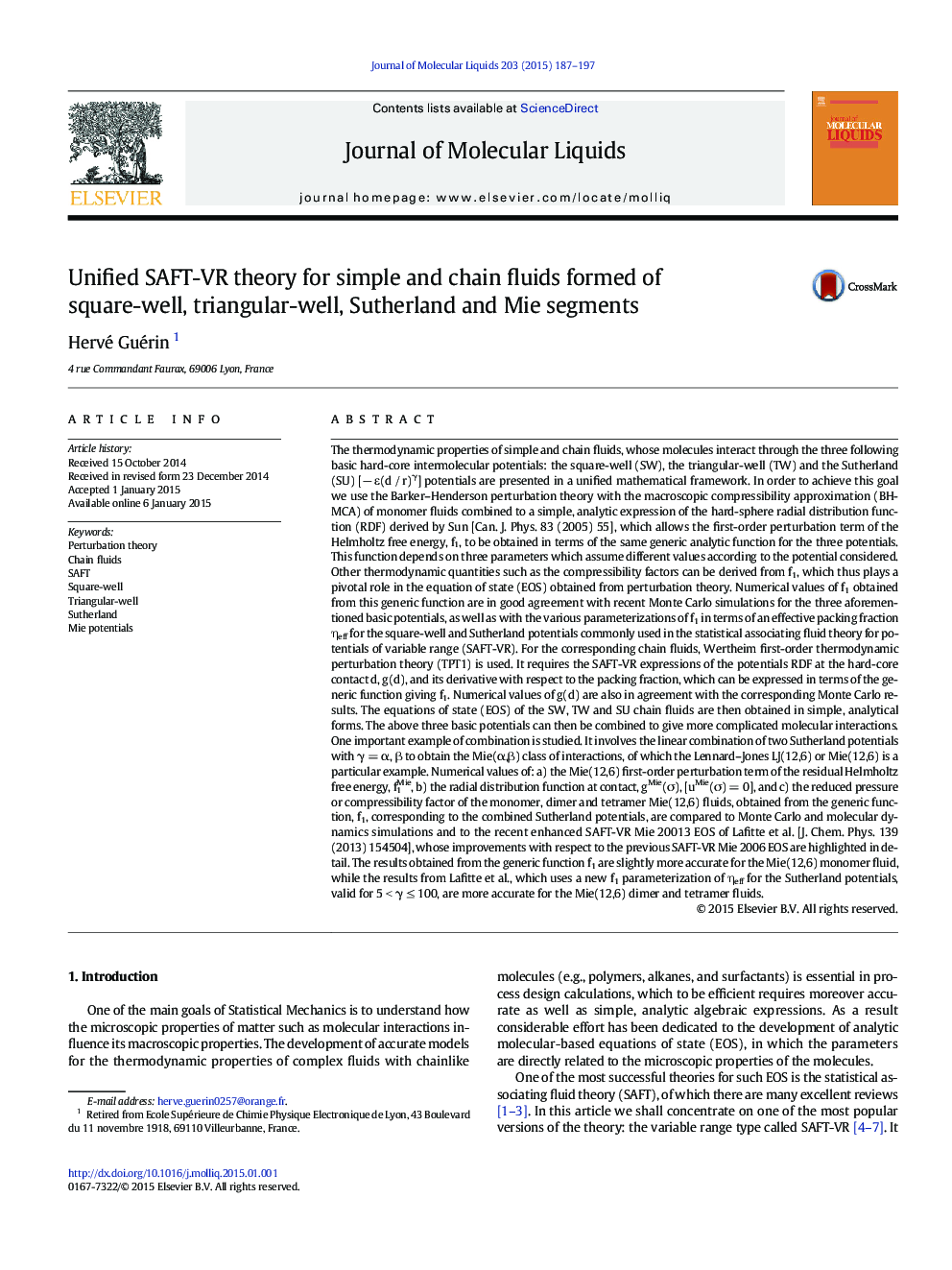| کد مقاله | کد نشریه | سال انتشار | مقاله انگلیسی | نسخه تمام متن |
|---|---|---|---|---|
| 5410830 | 1506567 | 2015 | 11 صفحه PDF | دانلود رایگان |
عنوان انگلیسی مقاله ISI
Unified SAFT-VR theory for simple and chain fluids formed of square-well, triangular-well, Sutherland and Mie segments
دانلود مقاله + سفارش ترجمه
دانلود مقاله ISI انگلیسی
رایگان برای ایرانیان
موضوعات مرتبط
مهندسی و علوم پایه
شیمی
شیمی تئوریک و عملی
پیش نمایش صفحه اول مقاله

چکیده انگلیسی
The thermodynamic properties of simple and chain fluids, whose molecules interact through the three following basic hard-core intermolecular potentials: the square-well (SW), the triangular-well (TW) and the Sutherland (SU) [â ε(d / r)γ] potentials are presented in a unified mathematical framework. In order to achieve this goal we use the Barker-Henderson perturbation theory with the macroscopic compressibility approximation (BH-MCA) of monomer fluids combined to a simple, analytic expression of the hard-sphere radial distribution function (RDF) derived by Sun [Can. J. Phys. 83 (2005) 55], which allows the first-order perturbation term of the Helmholtz free energy, f1, to be obtained in terms of the same generic analytic function for the three potentials. This function depends on three parameters which assume different values according to the potential considered. Other thermodynamic quantities such as the compressibility factors can be derived from f1, which thus plays a pivotal role in the equation of state (EOS) obtained from perturbation theory. Numerical values of f1 obtained from this generic function are in good agreement with recent Monte Carlo simulations for the three aforementioned basic potentials, as well as with the various parameterizations of f1 in terms of an effective packing fraction ηeff for the square-well and Sutherland potentials commonly used in the statistical associating fluid theory for potentials of variable range (SAFT-VR). For the corresponding chain fluids, Wertheim first-order thermodynamic perturbation theory (TPT1) is used. It requires the SAFT-VR expressions of the potentials RDF at the hard-core contact d, g(d), and its derivative with respect to the packing fraction, which can be expressed in terms of the generic function giving f1. Numerical values of g(d) are also in agreement with the corresponding Monte Carlo results. The equations of state (EOS) of the SW, TW and SU chain fluids are then obtained in simple, analytical forms. The above three basic potentials can then be combined to give more complicated molecular interactions. One important example of combination is studied. It involves the linear combination of two Sutherland potentials with γ = α, β to obtain the Mie(α,β) class of interactions, of which the Lennard-Jones LJ(12,6) or Mie(12,6) is a particular example. Numerical values of: a) the Mie(12,6) first-order perturbation term of the residual Helmholtz free energy, f1Mie, b) the radial distribution function at contact, gMie(Ï), [uMie(Ï) = 0], and c) the reduced pressure or compressibility factor of the monomer, dimer and tetramer Mie(12,6) fluids, obtained from the generic function, f1, corresponding to the combined Sutherland potentials, are compared to Monte Carlo and molecular dynamics simulations and to the recent enhanced SAFT-VR Mie 20013 EOS of Lafitte et al. [J. Chem. Phys. 139 (2013) 154504], whose improvements with respect to the previous SAFT-VR Mie 2006 EOS are highlighted in detail. The results obtained from the generic function f1 are slightly more accurate for the Mie(12,6) monomer fluid, while the results from Lafitte et al., which uses a new f1 parameterization of ηeff for the Sutherland potentials, valid for 5 < γ â¤Â 100, are more accurate for the Mie(12,6) dimer and tetramer fluids.
ناشر
Database: Elsevier - ScienceDirect (ساینس دایرکت)
Journal: Journal of Molecular Liquids - Volume 203, March 2015, Pages 187-197
Journal: Journal of Molecular Liquids - Volume 203, March 2015, Pages 187-197
نویسندگان
Hervé Guérin,